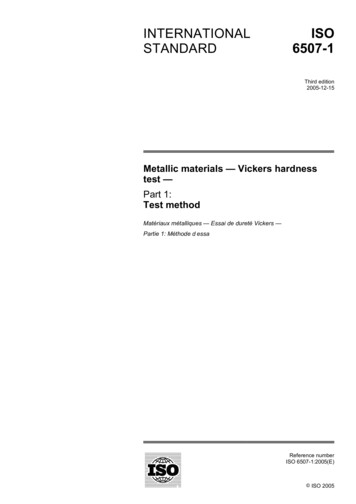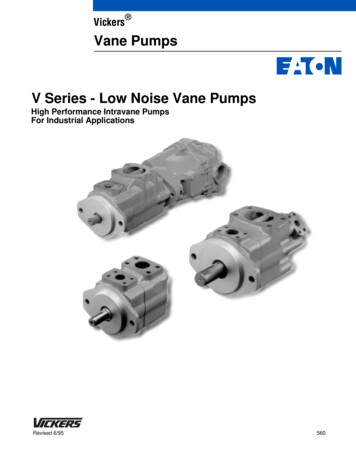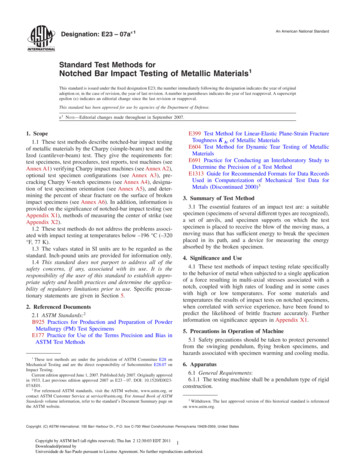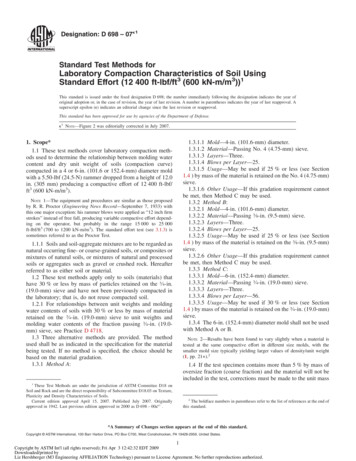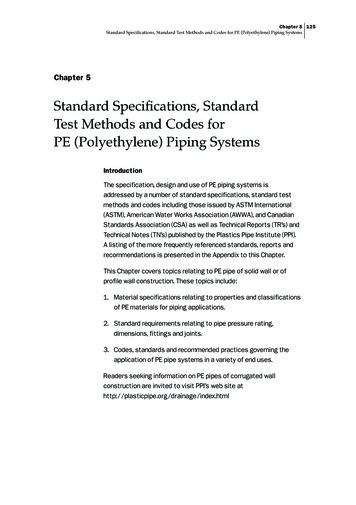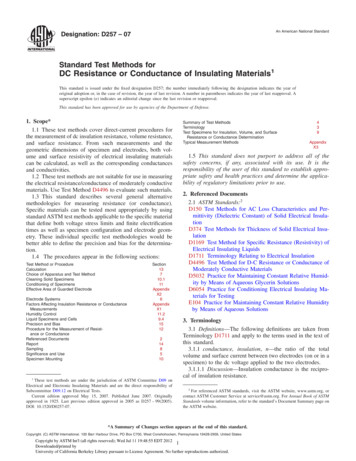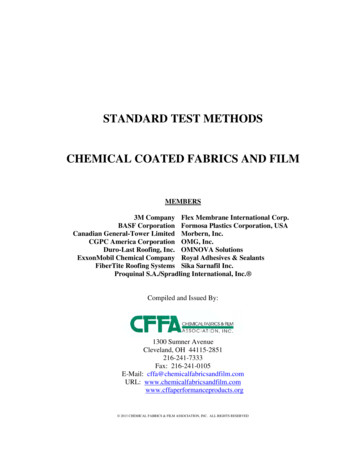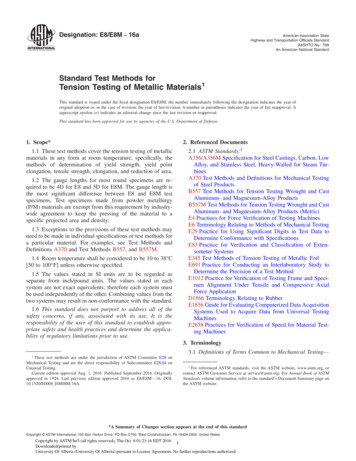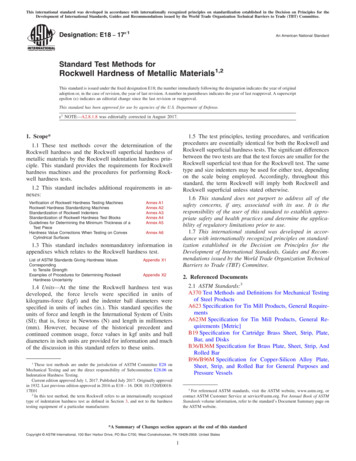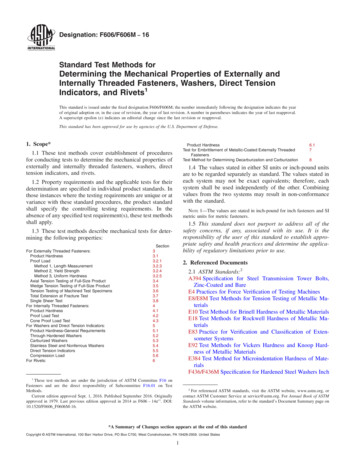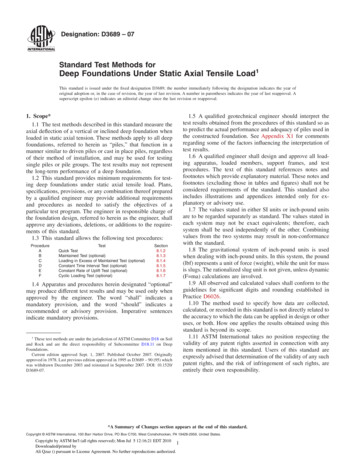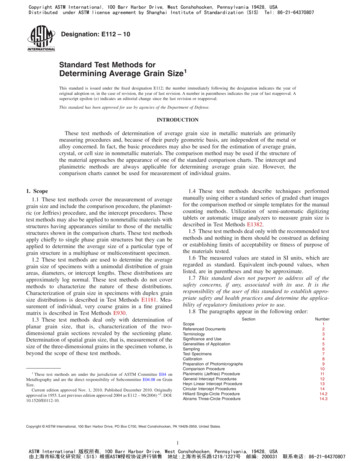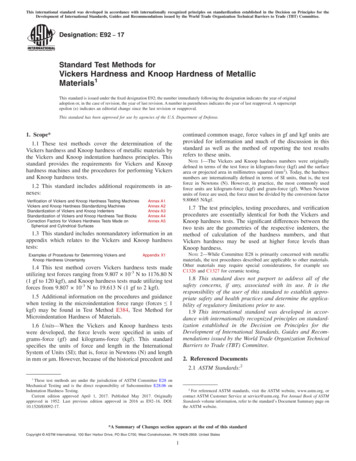
Transcription
This international standard was developed in accordance with internationally recognized principles on standardization established in the Decision on Principles for theDevelopment of International Standards, Guides and Recommendations issued by the World Trade Organization Technical Barriers to Trade (TBT) Committee.Designation: E92 17Standard Test Methods forVickers Hardness and Knoop Hardness of MetallicMaterials1This standard is issued under the fixed designation E92; the number immediately following the designation indicates the year of originaladoption or, in the case of revision, the year of last revision. A number in parentheses indicates the year of last reapproval. A superscriptepsilon ( ) indicates an editorial change since the last revision or reapproval.This standard has been approved for use by agencies of the U.S. Department of Defense.continued common usage, force values in gf and kgf units areprovided for information and much of the discussion in thisstandard as well as the method of reporting the test resultsrefers to these units.1. Scope*1.1 These test methods cover the determination of theVickers hardness and Knoop hardness of metallic materials bythe Vickers and Knoop indentation hardness principles. Thisstandard provides the requirements for Vickers and Knoophardness machines and the procedures for performing Vickersand Knoop hardness tests.NOTE 1—The Vickers and Knoop hardness numbers were originallydefined in terms of the test force in kilogram-force (kgf) and the surfacearea or projected area in millimetres squared (mm2). Today, the hardnessnumbers are internationally defined in terms of SI units, that is, the testforce in Newtons (N). However, in practice, the most commonly usedforce units are kilogram-force (kgf) and gram-force (gf). When Newtonunits of force are used, the force must be divided by the conversion factor9.80665 N/kgf.1.2 This standard includes additional requirements in annexes:Verification of Vickers and Knoop Hardness Testing MachinesVickers and Knoop Hardness Standardizing MachinesStandardization of Vickers and Knoop IndentersStandardization of Vickers and Knoop Hardness Test BlocksCorrection Factors for Vickers Hardness Tests Made onSpherical and Cylindrical SurfacesAnnex A1Annex A2Annex A3Annex A4Annex A51.7 The test principles, testing procedures, and verificationprocedures are essentially identical for both the Vickers andKnoop hardness tests. The significant differences between thetwo tests are the geometries of the respective indenters, themethod of calculation of the hardness numbers, and thatVickers hardness may be used at higher force levels thanKnoop hardness.1.3 This standard includes nonmandatory information in anappendix which relates to the Vickers and Knoop hardnesstests:Examples of Procedures for Determining Vickers andKnoop Hardness UncertaintyNOTE 2—While Committee E28 is primarily concerned with metallicmaterials, the test procedures described are applicable to other materials.Other materials may require special considerations, for example seeC1326 and C1327 for ceramic testing.Appendix X11.4 This test method covers Vickers hardness tests madeutilizing test forces ranging from 9.807 10-3 N to 1176.80 N(1 gf to 120 kgf), and Knoop hardness tests made utilizing testforces from 9.807 10-3 N to 19.613 N (1 gf to 2 kgf).1.8 This standard does not purport to address all of thesafety concerns, if any, associated with its use. It is theresponsibility of the user of this standard to establish appropriate safety and health practices and determine the applicability of regulatory limitations prior to use.1.9 This international standard was developed in accordance with internationally recognized principles on standardization established in the Decision on Principles for theDevelopment of International Standards, Guides and Recommendations issued by the World Trade Organization TechnicalBarriers to Trade (TBT) Committee.1.5 Additional information on the procedures and guidancewhen testing in the microindentation force range (forces 1kgf) may be found in Test Method E384, Test Method forMicroindentation Hardness of Materials.1.6 Units—When the Vickers and Knoop hardness testswere developed, the force levels were specified in units ofgrams-force (gf) and kilograms-force (kgf). This standardspecifies the units of force and length in the InternationalSystem of Units (SI); that is, force in Newtons (N) and lengthin mm or µm. However, because of the historical precedent and2. Referenced Documents2.1 ASTM Standards:21These test methods are under the jurisdiction of ASTM Committee E28 onMechanical Testing and is the direct responsibility of Subcommittee E28.06 onIndentation Hardness Testing.Current edition approved April 1, 2017. Published May 2017. Originallyapproved in 1952. Last previous edition approved in 2016 as E92–16. DOI:10.1520/E0092-17.2For referenced ASTM standards, visit the ASTM website, www.astm.org, orcontact ASTM Customer Service at service@astm.org. For Annual Book of ASTMStandards volume information, refer to the standard’s Document Summary page onthe ASTM website.*A Summary of Changes section appears at the end of this standardCopyright ASTM International, 100 Barr Harbor Drive, PO Box C700, West Conshohocken, PA 19428-2959. United States1
E92 173.1.4 Vickers hardness number, HV, n—the calculated resultfrom a Vickers hardness test, which is proportional to the testforce applied to the Vickers indenter divided by the surfacearea of the permanent indentation made by the indenter afterremoval of the test force.3.1.4.1 Discussion—The surface area of the permanent indentation made by the Vickers indenter is calculated basedpartly on the measured mean length of the two diagonals of theprojected area of the indentation.C1326 Test Method for Knoop Indentation Hardness ofAdvanced CeramicsC1327 Test Method for Vickers Indentation Hardness ofAdvanced CeramicsE3 Guide for Preparation of Metallographic SpecimensE6 Terminology Relating to Methods of Mechanical TestingE7 Terminology Relating to MetallographyE29 Practice for Using Significant Digits in Test Data toDetermine Conformance with SpecificationsE74 Practice of Calibration of Force-Measuring Instrumentsfor Verifying the Force Indication of Testing MachinesE140 Hardness Conversion Tables for Metals RelationshipAmong Brinell Hardness, Vickers Hardness, RockwellHardness, Superficial Hardness, Knoop Hardness, Scleroscope Hardness, and Leeb HardnessE175 Terminology of MicroscopyE177 Practice for Use of the Terms Precision and Bias inASTM Test MethodsE384 Test Method for Microindentation Hardness of MaterialsE691 Practice for Conducting an Interlaboratory Study toDetermine the Precision of a Test Method2.2 ISO Standards:3ISO 6507-1 Metallic Materials—Vickers hardness Test—Part 1: Test MethodISO/IEC 17011 Conformity Assessment—General Requirements for Accreditation Bodies Accrediting ConformityAssessment BodiesISO/IEC 17025 General Requirements for the Competenceof Testing and Calibration Laboratories3.1.5 Vickers hardness test, n—an indentation test in whicha Vickers square-based pyramidal diamond indenter havingspecified face angles is forced under specified conditions intothe surface of the test material, and, after removal of the testforce, the lengths of the two diagonals of the projected area ofthe indentation are measured to calculate the Vickers hardnessnumber.3.2 Definitions of Terms Specific to This Standard:3.2.1 standardization, n—to bring in conformance to aknown standard through verification or calibration.3.2.2 microindentation hardness test, n—a hardness test,normally in the Vickers or Knoop scales, using test forces inthe range of 9.807 10-3 to 9.807 N (1 to 1000 gf).3.2.3 macroindention hardness test, n—a hardness test usingtest forces normally higher than 9.807 N (1 kgf). Macroindentation tests include Vickers, Rockwell and Brinell.NOTE 3—Use of the term microhardness should be avoided because itimplies that the hardness, rather than the force or the indentation size, isvery low.3.2.4 scale, n—a specific combination of indenter (Knoop orVickers) and the test force (kgf).3.2.4.1 Discussion—For example, HV 10 is a scale definedas using a Vickers indenter and a 10 kgf test force and HK 0.1is a scale defined as using a Knoop indenter and a 100 gf testforce. See 5.10 for the proper reporting of the hardness leveland scale.3. Terminology and Equations3.1 Definitions of Terms—For the standard definitions ofterms used in this test method, see Terminology E6 andTerminology E7.3.1.1 indentation hardness, n—the hardness as evaluatedfrom measurements of area or depth of the indentation made byforcing a specified indenter into the surface of a material underspecified static loading conditions.3.1.2 Knoop hardness number, HK, n—the calculated resultfrom a Knoop hardness test, which is proportional to the testforce applied to the Knoop indenter divided by the projectedarea of the permanent indentation made by the indenter afterremoval of the test force.3.1.2.1 Discussion—The projected area of the permanentindentation made by the Knoop indenter is calculated basedpartly on the measured length of the long diagonal of theprojected area of the indentation.3.1.3 Knoop hardness test, n—an indentation test in which aKnoop rhombic-based pyramidal diamond indenter havingspecified edge angles, is forced under specified conditions intothe surface of the test material, and, after removal of the testforce, the length of the long diagonal of the projected area ofthe indentation is measured to calculate the Knoop hardnessnumber.3.2.5 as-found condition, n—the state of the hardness machine as reflected by the initial verification measurements madeprior to performing any cleaning, maintenance, adjustments orrepairs associated with an indirect verification.3.2.6 hardness machine, n—a machine capable of performing a Vickers or Knoop hardness test.3.2.7 hardness testing machine, n—a Vickers or Knoophardness machine used for general testing purposes.3.2.8 hardness standardizing machine, n—a Vickers orKnoop hardness machine used for the standardization ofVickers or Knoop hardness test blocks.3.2.8.1 Discussion—A hardness standardizing machine differs from a hardness testing machine by having tighter tolerances on certain parameters.3.3 Equations:3.3.1 The average d̄ of a set of n diagonal length measurements d1, d2, , dn is calculated as:3Available from American National Standards Institute (ANSI), 25 W. 43rd St.,4th Floor, New York, NY 10036, http://www.ansi.org.d̄ 52d 1 1d 2 1 1d nn(1)
E92 1725 gf) or for indentations with diagonals smaller than about 25µm (see Test Method E384). For isotropic materials, the twodiagonals of a Vickers indentation are equal in length.where each of the individual diagonal measurements d1, d2, , dn is the mean of the two diagonal length measurements inthe case of a Vickers indentation, or is the long diagonal lengthmeasurement in the case of a Knoop indentation.3.3.2 The repeatability R in the performance of a Vickers orKnoop hardness machine at each hardness level, under theparticular verification conditions, is determined from n diagonal measurements made on a standardized test block as part ofa performance verification. The repeatability is estimated as thepercent range of n diagonal measurements with respect to themeasured average hardness value as:R 5 100 3Sd max 2 d mind̄D4.5 The Knoop indenter usually produces similar hardnessnumbers over a wide range of test forces, but the numbers tendto rise as the test force is decreased. This rise in hardnessnumber with lower test forces is often more significant whentesting higher hardness materials, and is increasingly moresignificant when using test forces below 50 gf (see Test MethodE384).4.6 The elongated four-sided rhombohedral shape of theKnoop indenter, where the length of the long diagonal is 7.114times greater than the short diagonal, produces narrower andshallower indentations than the square-based pyramid Vickersindenter under identical test conditions. Hence, the Knoophardness test is very useful for evaluating hardness gradientssince Knoop indentations can be made closer together thanVickers indentations by orienting the Knoop indentations withthe short diagonals in the direction of the hardness gradient.(2)where:dmax the longest diagonal length measurement made on thestandardized test block,dmin the shortest diagonal length measurement made onthe standardized test block, andd̄ the average (see 3.3.1) of the n diagonal lengthmeasurements made on the standardized test block.5. Principle of Test and Apparatus3.3.3 The error E in the performance of a Vickers or Knoophardness machine at each hardness level, relative to a standardized reference value, is calculated as a percent error determinedas:E 5 100 3S?d̄ 2 d refd ref?D5.1 Vickers and Knoop Hardness Test Principle—The general principle of the Vickers and Knoop indentation hardnesstest consists of two steps.5.1.1 Step 1—The applicable specified indenter is broughtinto contact with the test specimen in a direction normal to thesurface, and the test force F is applied. The test force is held fora specified dwell time and then removed.5.1.2 Step 2—For the Vickers hardness test, the lengths ofthe two diagonals are measured and the mean diagonal lengthis calculated, which is used to derive the Vickers hardnessvalue. For the Knoop hardness test, the length of the longdiagonal is measured, which is used to derive the Knoophardness value.5.1.3 Most materials will exhibit some elastic recoverywhen the indenter is removed after the loading cycle. However,for the purposes of calculating the hardness results from theindentation diagonal lengths, it is assumed that the indentationretains the shape of the indenter after the force is removed. InKnoop testing, it is assumed that the ratio of the long diagonalto the short diagonal of the indentation is the same as for theindenter.(3)where:d̄ the av
2.1 ASTM Standards:2 1 These test methods are under the jurisdiction of ASTM Committee E28 on Mechanical Testing and is the direct responsibility of Subcommittee E28.06 on Indentation Hardness Testing. Current edition approved April 1, 2017. Published May 2017. Originally approved in 1952. Last previous edition approved in 2016 as E92–16. DOI:
